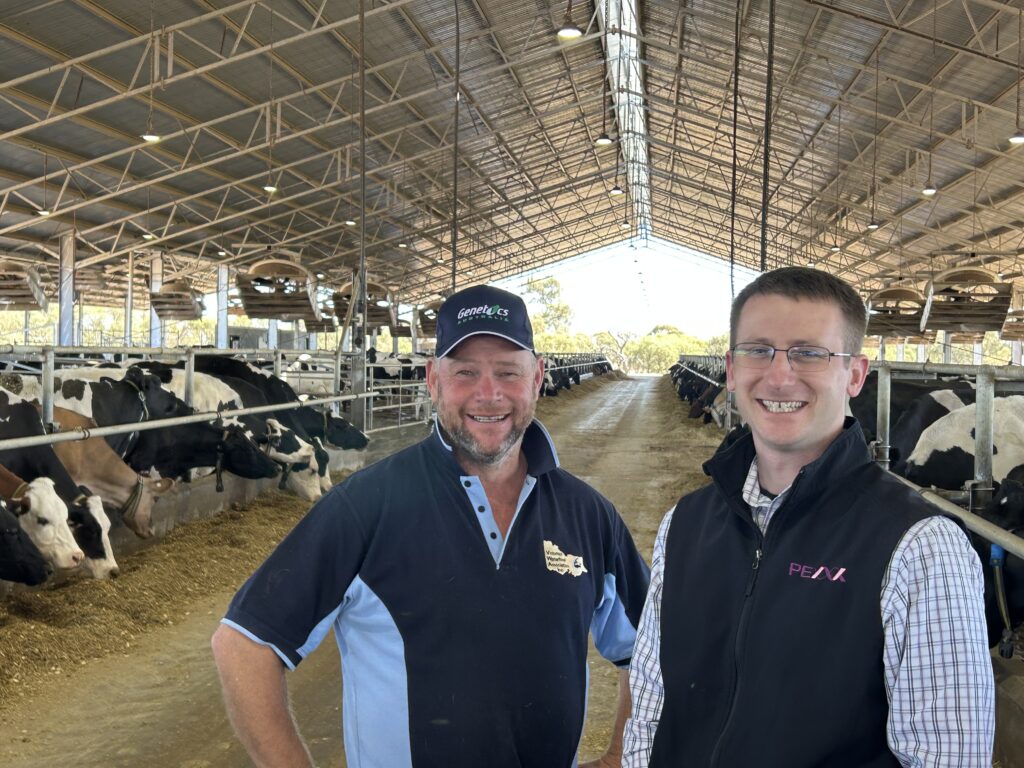Información interna únicamente - confidencial para no compartir externamente.
Información interna únicamente - confidencial para no compartir externamente.


With a flat milk contract and 720 cows in a barn, Dehne and Sarah Vinnicombe are used to a daily calving routine. But a group of calves hitting the ground in March will hold special significance for the farmers from Calivil in Northern Victoria, Australia. They will be their first calves born under the Co-operator program, a collaboration between PEAK Genetics and Genetics Australia as part of the URUS joint venture.
Dehne and Sarah are among a small group of Victorian farms in the Co-operator herd program, which brings together the best of Australian and American genetic pools. For Dehne, the program is a way to increase his herd’s genetic base and access international cow families with Australian genomic performance breeding values.
“Without a doubt we’ll finish up with a better herd,” he says. “We’re looking to increase the genetic base of the herd and find the cow families that fit. By using genomics, we can see which ones come up better.”
“It’s a win-win for everyone. Genetics Australia will benefit from new genomic bulls, and we’ll get some extra cow families.”
Females born in the program stay at the Co-operator’s farm, with elite offspring added to future breeding schedules. The genomic breeding values of male calves will be assessed, and elite males will join AI with Genetics Australia for Australian farmers to access.
Genetics Australia regional sales manager Gerald Brislin says the Co-operator program is “combining the best of both worlds”.
“It’s not unique to have embryos made in the USA coming to Australia, but what is unique is that we’re sending our local semen to the US to PEAK Genetics to sire these embryos that come back,” Gerard said.
“It’s a unique opportunity to access international cow families with Australian genomic performance breeding values.”
Genetics Australia chose to initially position the collaborative program with the Holstein breed with embryos generated by TransOva Genetics in the U.S., whilst a large cohort of donor females are selected and genotyped from the nucleus breeding program at PEAK Genetics.
Gerard says the uptake of technologies such as gender-sorted semen has meant fewer elite bull calves are being offered to AI companies in Australia, so diversity was needed in the breeding program. However, he adds that the Australia breeder remains an important source in providing genetics for the future.
We’re still encouraging local breeder herds to sample bulls with the potential for these young bulls to enter the young sire program. Breed leading Holstein bulls in recent intakes at Genetics Australia have come from Australian breeder herds, such as AUSTRALIND and more recently JOBOLT and JORDLIV, so it is important to continue to draw on local genetics. Genomic technology is far-reaching around the world today, it doesn’t matter where the male or female is born in the world, to have a breeding program performing at a high level, it is important to find the best and breed them better which is what the co-operator herd program offers Genetics Australia and its shareholders.
Gerald Brislin, Genetics Australia Regional Sales Manager
Gerard added that the embryo services at Genetics Australia’s Camperdown facility enabled this program to happen. “This is a great example of collaboration, which is something farmers want us to do.”
Dehne says the invitation to be part of such an exciting venture between Genetics Australia and PEAK Genetics was too good to pass up.
It follows the family’s shift four years ago to a free stall barn that houses 720 mostly Holstein cows, generating feed from their 1214-hectare property.
"We owned a few farms and wanted to consolidate them and thought a barn was better for the weather conditions,” Deyne said.
“We were feeding a lot on feed pads and wasting too much. It let us down when it was too hot and wet because it had no cover, which are the main two times you need a feed pad.”
After some initial issues, the cows are now milking exceptionally well in the barn.
They started with 400 cows in the barn before buying a herd from Manna Farms in South Australia to increase their numbers. The herd will continue to grow, with heifers and young stock joining in the next 18 months.
Traditionally, the Vinnicombes calved twice a year, but it’s now every day for the flat milk contract.
I’ve worked with GA since I was a teenager. I used to get bulls ready, take photographs of bulls and cows for catalogues, and we sold bulls back to GA when I was at home. We’ve had a partnership for all that length of time.
Dehne Vinnicombe, 49, has a long history with Genetics Australia
The latest connection is the “next step” that will benefit both parties.
“We are using top-end cows and will get good heifers out of them and it also addresses what is happening with bobby calves,” Dehne said.
“We’ve had two lots of embryos go in, and I’m looking forward to seeing them on the ground running around. We see it as a big win for us and a great ongoing partnership.”
Tenga en cuenta que todas las traducciones de este sitio se generan mediante tecnología de IA. Si detecta algún error o tiene alguna sugerencia de mejora, envíe un correo electrónico al equipo de comunicación de URUS a la siguiente dirección [email protected].